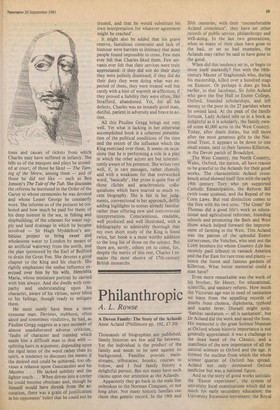Doomed king
Christopher Hibbert
King Charles I Pauline Gregg (Dent pp. 496, £12.50) 'Upon my word!' the Prince Regent once exclaimed after scrutinising one of Van Dyck's pictures of his ancestor, King Charles I, 'What a doleful face!' Bernini had expressed a similar opinion when studying the artist's triple portrait which had been sent to him in Rome to help him in the execution of a bust. He pronounced the countenance depicted as that of a man 'doomed'. 'Never,' he said, 'have I beheld features more unfortunate.' There is mystery as well as sadness in the heavylidded, lugubrious gaze that Van Dyck captured, as the King, exquisitely clothed, a pearl ear-ring resting upon his high lace collar, clutches to his breast, in a characteristically protective gesture, the full rich silk of his dress. The Regent remarked upon this, too. 'What was he really like?' he asked one of his sisters. 'The more I read about him the less I seem I know.'
Since then numerous attempts have been made to unravel the mystery, none of them entirely successful. The failures have not been due to lack of material. Sources are, indeed, abundant. There are letters, journals, speeches, documents and contemporary accounts in such intimidating numbers that all but the most tirelessly industrious historian must find them forbidding. But the difficulties presented by their reduction and interpretation have proved peculiarly intractable, not least because so many of their authors were so wildly partisan and the King did not always choose to say what he meant. Now Pauline Gregg has devoted herself to the problem in a painstaking book whose length has allowed her space for many interesting diversions. She writes, for instance, about the symp toms and causes of rickets from which Charles may have suffered in infancy. She tells us of the masques and plays he attended at court, of those he liked — The Taming of the Shrew, among them — and of those he did not like — such as Ben Jonson's The Tale of the Tub. She discusses the reforms he instituted in the Order of the Garter to whose ceremonies he was devoted and whose Lesser George he constantly wore. She informs us of the pictures he collected and how much he paid for them; of his deep interest in the sea, in fishing and shipbuilding; of the schemes for water supply and land drainage in which he became involved — Sir Hugh Myddelton's ambitious project to bring sweet and wholesome water to London by means of an artificial waterway from the north, and the plan sponsored by the Earl of Bedford to drain the Great Fen. She devotes a good chapter to the King and his church. She rightly emphasises the undue influence exercised over him by his wife, Henrietta Maria, whose miniature portrait he carried with him always. And she dwells with sympathy and understanding upon his character, aware of his virtues, never blind to his failings, though ready to mitigate them.
He must surely have been a most tiresome man. Devious, stubborn, often aloof and sometimes vindictive, he had, as Pauline Gregg suggests in a rare moment of almost unadulterated adverse criticism, 'faults of character and training which made him a difficult man to deal with — splitting hairs in argument, depending upon the rigid letter of the word rather than its spirit, a tendency to discount the means if the desired end could be achieved, too obvious a reliance upon Guicciardini and his Maxims . . . He lacked subtlety and the lighter touch. . . When driven into a corner he could become obstinate and, though he himself would have shrunk from the accusation, there was a grain of justification in his opponents' belief that he could not be trusted, and that he would substitute his own interpretation for whatever agreement might be reached'.
It might also be added that his grave reserve, fastidious constraint and lack of humour were barriers to intimacy that most people found impossible to cross. Few men ever felt that Charles liked them. Few servants ever felt that their services were truly appreciated: if they did not do their duty they were politely dismissed; if they did do their duty they were doing what was expected of them, they were treated well but rarely with a hint of warmth or affection; if they proved a liability they were often, like Strafford, abandoned. Yet, for all his defects, Charles was an innately good man, dutiful, patient in adversity and brave in action.
All this Pauline Gregg brings out very well. Yet what is lacking in her otherwise accomplished book is a coherent presentation of the political conditions of the time and the extent of the influence which the King exercised over them. It seems on occasions that he is performing a role in a play in which the other actors are but intermittently aware of his presence. She writes very well, if, in rare passages, rather clumsily and with a weakness for that overworked word, 'basically'. Her prose is quite free of those cliches and anachronistic colloquialisms which have marred so much recent biography. She is fair in her judgments, conventional in her approach, deftly adding highlights to scenes already familiar rather than offering new and controversial interpretations. Conscientious, readable, well produced and well illustrated, with a bibliography so admirably thorough that my own short study of the King is listed twice, her book is a most worthy addition to the long list of those on the subject. But there are, surely, others yet to come, for, despite the merits of this one, Charles I remains the most elusive of 17th-century British monarchs.



































 Previous page
Previous page